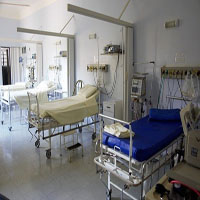Physiological deterioration in the Emergency Department: The SNAP40-ED study

Accepted: 8 July 2021
All claims expressed in this article are solely those of the authors and do not necessarily represent those of their affiliated organizations, or those of the publisher, the editors and the reviewers. Any product that may be evaluated in this article or claim that may be made by its manufacturer is not guaranteed or endorsed by the publisher.
Continuous novel ambulatory monitoring may detect deterioration in Emergency Department (ED) patients more rapidly, prompting treatment and preventing adverse events. Single-centre, open-label, prospective, observational cohort study recruiting high/medium acuity (Manchester triage category 2 and 3) participants, aged over 16 years, presenting to ED. Participants were fitted with a novel wearable monitoring device alongside standard clinical care (wired monitoring and/or manual clinical staff vital sign recording) and observed for up to 4 hours in the ED. Primary outcome was time to detection of deterioration. Two-hundred and fifty (250) patients were enrolled. In 82 patients (32.8%) with standard monitoring (wired monitoring and/or manual clinical staff vital sign recording), deterioration in at least one vital sign was noted during their four-hour ED stay. Overall, the novel device detected deterioration a median of 34 minutes earlier than wired monitoring (Q1, Q3 67,194; n=73, mean difference 39.48, p<0.0001). The novel device detected deterioration a median of 24 minutes (Q1, Q3 2,43; n=42) earlier than wired monitoring and 65 minutes (Q1, Q3 28,114; n=31) earlier than manual vital signs. Deterioration in physiology was common in ED patients. ED staff spent a significant amount of time performing observations and responding to alarms, with many not escalated. The novel device detected deterioration significantly earlier than standard care.
Findlay GP, Shotton H, Kelly K, et al. Time to intervene? NCEPOD 2012. Available from: http://www.ncepod.org.uk/2012report1/downloads/CAP_fullreport.pdf
Kause J, Smith G, Prytherch D, et al. A comparison of antecedents to cardiac arrests, deaths and emergency intensive care admissions in Australia and New Zealand, and the United Kingdom – the ACADEMIA study. Resuscitation 2004;62:275-82. DOI: https://doi.org/10.1016/j.resuscitation.2004.05.016
Griffiths JR, Kidney EM. Current use of early warning scores in UK emergency departments. Emerg Med J 2012;29:65–6. DOI: https://doi.org/10.1136/emermed-2011-200508
The Royal College of Emergency Medicine. Position statement National Early Warning Score (NEWS) for Adult Patients attending Emergency Departments 2016. Accessed 19 July 2021. Available form: https://www.rcem.ac.uk/docs/News/CEM10125-Position%20statement%20-%20NEWS%20for%20adult%20patients%20attending%20EDs%20-%20June%202016.pdf
Taenzer AH, Pyke JB, McGrath SP, Blike GT. Impact of pulse oximetry surveillance on rescue events and intensive care unit transfers: a before-and-after concurrence study. Anesthesiology 2010;112:282-7. DOI: https://doi.org/10.1097/ALN.0b013e3181ca7a9b
Schmidt PE, Meredith P, Prytherch DR, et al. Impact of introducing an electronic physiological surveillance system on hospital mortality. BMJ Qual Saf 2015;24:10-20. DOI: https://doi.org/10.1136/bmjqs-2014-003073
Reed MJ, McGrath M, Black PL, et al. Detection of physiological deteriorationby the SNAP40 wearable devicecompared to standard monitoring devices in the emergency department:the SNAP40-ED study. Diagnostic Prognostic Res 2018;2:18. DOI: https://doi.org/10.1186/s41512-018-0040-7
Royal College of Physicians. National Early Warning Score (NEWS) 2. Accessed 20th November 2020. Accessed 20th November 2020. Available from: https://www.rcplondon.ac.uk/projects/outputs/national-early-warning-score-news-2
Drummond GB, Bates A, Mann J, Arvind DK. Validation of a new non-invasive automatic monitor of respiratory rate for postoperative subjects. Br J Anaesth 2011;107:462–9. DOI: https://doi.org/10.1093/bja/aer153
Brekke IJ, Puntervoll LH, Pedersen PB, et al. The value of vital sign trends in predicting and monitoring clinical deterioration: A systematic review. PLoS One 2019;14:e0210875. DOI: https://doi.org/10.1371/journal.pone.0210875
Fleischman W, Ciliberto B, Rozanski N, et al. Emergency department monitor alarms rarely change clinical management: An observational study. Am J Emerg Med 2020;38:1072-6. DOI: https://doi.org/10.1016/j.ajem.2019.158370
Clifton DA, Clifton L, Sandu D, et al. ‘Errors’ and omissions in paper-based early warning scores: the association with changes in vital signs—a database analysis. BMJ Open 2015;5:e007376. DOI: https://doi.org/10.1136/bmjopen-2014-007376
PAGEPress has chosen to apply the Creative Commons Attribution NonCommercial 4.0 International License (CC BY-NC 4.0) to all manuscripts to be published.


 https://doi.org/10.4081/ecj.2021.9711
https://doi.org/10.4081/ecj.2021.9711







